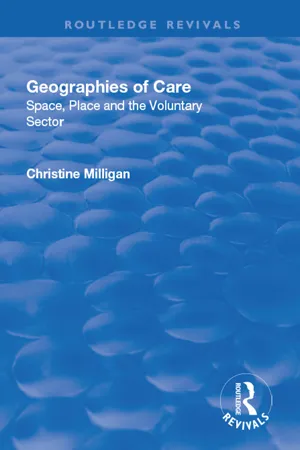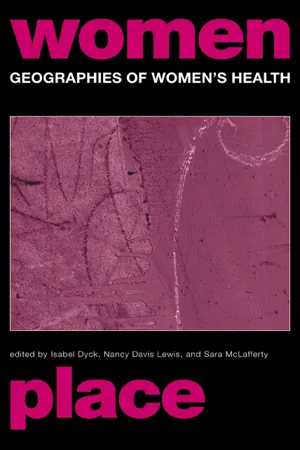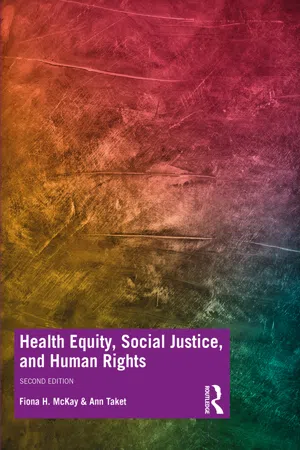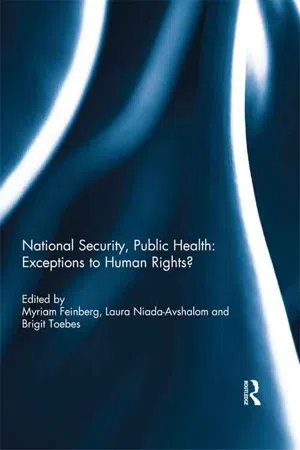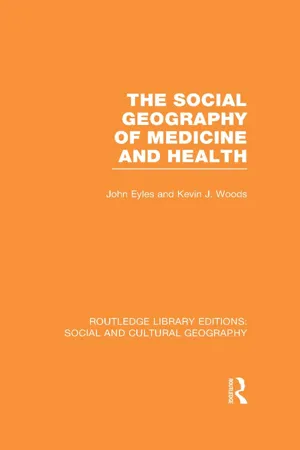Health and Human Rights
Health and human rights refers to the intersection of public health and human rights principles, emphasizing the right to health as a fundamental human right. It encompasses the understanding that health is not only a medical issue but also a social, economic, and political one, and that addressing health disparities and promoting health equity are essential components of upholding human rights.
5 Key excerpts on "Health and Human Rights"
- eBook - ePub
Geographies of Care
Space, Place and the Voluntary Sector
- Christine Milligan(Author)
- 2017(Publication Date)
- Routledge(Publisher)
...2 Geographical Perspectives on Health Introduction As care has moved from institutional to community-based sites of delivery, concern has focused not only on the relocation of the locus of care, but also on the new sets of actors and agencies involved with its planning and provision. Attention is drawn to the ways in which decisions are made and how the social processes of care reform operate in particular places. The relationship between healthcare and the means through which social, cultural, political and economic influences alter the experience of health and illness across space and within places has been of particular interest to medical geographers in recent years. The study upon which this book is based builds on work that has emerged from several strands of contemporary geographical thinking. Such work maintains that for a clearer understanding of how and why specific patterns of health and healthcare emerge in particular places at particular times, there is a need to extend the focus of medical geography to incorporate a wider view of health and healthcare. These broadly embody the recognition of a need to move away from bio-medical approaches to the geographical analysis of health issues, to incorporate social models of health and healthcare. Such approaches also highlight the potential benefit of integrating multi-disciplinary perspectives to geographical analyses, and the need to understand how wider contextual factors impact on experiences of health and healthcare. To understand why these issues are of importance here, this chapter gives a brief history of the development of medical geographical thinking, identifying some of the main elements that have informed the study...
- eBook - ePub
Geographies of Women's Health
Place, Diversity and Difference
- Nancy Davis Lewis, Isabel Dyck, Sara McLafferty, Nancy Davis Lewis, Isabel Dyck, Sara McLafferty(Authors)
- 2012(Publication Date)
- Routledge(Publisher)
...In the midst of the process of reconceptualizing health, Canadian geographers noted the potential contribution of their discipline to the project of “achieving health for all” (Rosenberg et al. 1990). Since then, medical, social, and cultural geographers have explored the contribution of social theory to understanding health, health care, and disability issues, and in so doing created a “new” medical geography or “health geography.” Engaging with concepts of space and place in new and varied ways and working with a “cultural turn” throughout human geography, geographers have analyzed health, illness, and health care access as phenomena with intricate links between the “personal,” the local, and global processes. Calls to reinsert space and place in medical geography were accompanied with a reworking of these concepts. Place, rather than being seen simply as location with the concomitant understanding of space as a “container” of action, is theorized as a relational and dynamic concept (Jones and Moon 1993; Kearns 1993). Incorporation of social theory in analyses also brought health geography closer to work in cognate areas. An emphasis on narrative and a focus on the body, as both corporeal and discursively inscribed, forged new spaces for inquiry (see for example, Dorn and Laws 1994; Kearns 1995, 1997). Experiential accounts, the interrogation of medical categories, and the spatial and discursive constitution of the “deviant” bodies of the physically or mentally ill are areas commanding recent attention. A special issue of Environment and Planning D: Society and Space (1997) and collected volumes concerned with illness and disability (Butler and Parr 1999; Kearns and Gesler 1998) signal an emerging concentration of work in the spirit of the “new” health geography...
- eBook - ePub
- Fiona McKay, Ann Taket(Authors)
- 2020(Publication Date)
- Routledge(Publisher)
...5 HEALTH EQUITY AND HUMAN RIGHTS Ann Taket and Fiona H. McKay The links between Health and Human Rights In understanding the links between Health and Human Rights, it is useful to distinguish three different, but interacting components (WHO 2002a). First, human rights violations can directly affect health: for example, torture, slavery, violence against women and children, and harmful traditional practices. Second, the promotion of human rights, in particular those connected to the social determinants of health, for example rights to education, to food and nutrition, shelter, and employment, lead to reduced vulnerability to ill health and promote health. Third, health development can involve promotion or violation of human rights, depending on how it affects rights such as the right to participation, freedom from discrimination, right to information, and right to privacy. There is a reciprocal impact of Health and Human Rights. The promotion, protection, restriction, or violations of human rights have direct and indirect impacts on health and wellbeing, in the short, medium, and long term. CASE STUDY: DOMESTIC VIOLENCE – A MAJOR PUBLIC Health and Human Rights ISSUE Domestic violence, abuse against women by current or previous intimate partners, is a major public health problem globally (García-Moreno et al. 2005). It occurs in all countries irrespective of culture, socio-economic status, or religion, and occurs in all types of relationships, both same sex and heterosexual (Krug et al. 2002). The context and severity of violence by men against women makes domestic violence against women a much larger problem in public health terms (Krug et al. 2002; WHO 1997). Intimate partner abuse has severe short- and long-term health consequences, both physical and mental, for the partner experiencing abuse, and for any children in the family (Itzin et al...
- Myriam Feinberg, Laura Niada-Avshalom, Brigit Toebes(Authors)
- 2017(Publication Date)
- Routledge(Publisher)
...In relation to this, there is an increasing emphasis on the so-called ‘social determinants of health’, i.e. the ‘conditions in which people are born, grow, live, work and age’. 16 It is increasingly stressed that illness, chronic diseases and disability, as well as socio-economic health inequalities more generally, form important public health concerns. To quote Lawrence Gostin, a key scholar in this debate: ( … ) global efforts should be directed toward universal assurance of the essential conditions for health: population-level strategies drawn from the tool box of public health; fully affordable, accessible, high quality health care for all; and a wide range of policies beyond the health sector to address the social determinants of health. 17 As such, Gostin establishes a link between public health and the need to provide good and accessible health care and other health-related services. To bring this back to human rights law: this emphasis on ‘health security’ and on ‘socio-economic health inequalities’ raises the question of how the ‘right to health’, as also stipulated in the Constitution of the WHO, can strengthen and reinforce such claims on the international plane. Addressing the more narrow aim of the spread of infectious diseases potentially raises tensions with the civil and political rights of individuals. Fostering access to health services and tackling health inequalities, on the other hand, does not necessarily create such tensions but rather relies on a key component of the right to health that stands separately from civil and political human rights...
- eBook - ePub
- John Eyles, Kevin Woods(Authors)
- 2014(Publication Date)
- Routledge(Publisher)
...We make no apology for being selective. Selection is of course biased towards our own particular interests. We also believe that an exhaustive list of geographical projects to be counter productive. Indeed, as Shannon (1980) avers, a disciplinary perspective may be a major hindrance to health research. We have concentrated on the social, seeing explorations of the health-health care-society relationship as central to understanding the social realities of the advanced industrial nations and the health promotion strategies of many Third World countries. We have mainly approached ‘the social’ through the behavioural-phenomenological and materialist perspectives, seeing ‘the geographical’ as a pertinent contribution to these routes to understanding and explanation. We do not regard the more ‘spatial’ aspects of the geographical perspective as irrelevant or unimportant. Analyses of the relationships between disease, medicine and environment and those between resource allocation and territorial structure contribute significantly to our comprehension of health. Medical ecological and epidemiological studies, perhaps employing the biomedical perspective, are particularly important in the developing world, while spatial health organisation work, utilising possibly a behaviourally modified economic approach, is useful for furthering our knowledge of the problems of health care delivery. Our own approach has ranged widely away from the traditional concerns of health per se. We have felt it necessary to examine, for example, aspects of social policy, welfare, poverty, science and technology. All these phenomena are implicated in the relationship between health and society. Indeed, this relationship must come to the fore if society is seen as a structured totality with health as a part of this whole. But the relationship is not one-way – it is dialectical...
